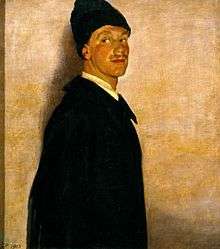Robert Allerton
Robert Henry Allerton (March 20, 1873 – December 22, 1964), born in Chicago, Illinois, United States, was the son and heir of First National Bank of Chicago co-founder Samuel Allerton.[1] A philanthropist for most of his life, he left Allerton Garden, the Honolulu Academy of Art, the Art Institute of Chicago, and Robert Allerton Park as legacies for the public to enjoy.

Robert Henry Allerton enjoyed traveling to countries around the world. In these countries he would buy statues of all kinds, which were then placed in his estate. Most of the statues are no longer on the estate, now called Robert Henry Allerton Park, but there are still a few left.
Early life
Robert Henry Allerton was born on March 20, 1873, as the second child and only son to Samuel Waters Allerton (1828–1914) and Pamilla Thompson Allerton (1840–1880). Through an entirely paternal line, Robert Henry Allerton was descended from Isaac Allerton, an English Puritan who came to America on the Mayflower in 1620.[2] Samuel Allerton was a self-made man who made his millions in land, livestock, banking, and other commercial enterprises. Pamilla Allerton died in 1880, five days before Robert's 7th birthday. Two years later, Samuel Allerton married Agnes Thompson, Pamilla's younger sister. Agnes Thompson Allerton (1858–1924) became mother, friend, and cultural mentor for her stepson/nephew. She kindled his interests in literature, music, gardening, and above all, visual arts.
The Allertons lived on Prairie Avenue in Chicago, which was the most fashionable residential street in that city in the 1800s. The Allertons were neighbors of Marshall Field, the Pullmans, Kimballs, and Armours. Robert attended Allen Academy and Harvard School in Chicago, after which he and friend Frederic Clay Bartlett, were sent east to St. Paul's School, a prestigious college prep school in Concord, New Hampshire. The young Chicagoans decided not to go on to college, but rather to study art in Europe.
In 1922 he met John Gregg (1899–1986), an orphan and aspiring architect, who after the stock market crash of 1929, came to live with Allerton.[3] He was to become his lifelong companion.[3] After a change in Illinois law in 1959, he legally adopted Gregg as his son.[3][4] After their deaths, Allerton and Gregg's mingled ashes were scattered on Lawai Bay, Kauai, Hawaii. While closeted, it is believed that Allerton and Gregg were involved in a homosexual relationship, at a time when American society was not accepting of such relationships.[3][5][6][7] Same-sex adult adoption had been a utilized by couples in the time before the legalization of same-sex marriages and unions.
"The Farms"
Allerton's estate began in 1897 when Allerton decided to become a farmer. By 1914 his "farm" had grown to over 12,000 acres and became known as "The Farms".[8] Now called Robert Allerton Park, it is owned and operated by the University of Illinois near Monticello, Illinois. The botanical journal Allertonia and the two estate parks are named after Robert Allerton. The main building of the Art Institute of Chicago, where he served as the honorary president and trustee, was renamed the Allerton Building in his honor in 1968.
Hawaiʻi
The former Hawaiian Royal tropical estate, located on the island of Kauaʻi in Hawaiʻi, is now called the Allerton Garden. After John Gregg Allerton's death it became part of the National Tropical Botanical Garden, with public tours.
See also
- Robert Allerton Park ("The Farms," Illinois)
- Allerton Garden (Kaua'i, Hawaii)
References
- "ALLERTON LEFT $20,000,000.; Chicago Banker Bequeathed Fortune to Family and Gift to Servant" (PDF).
- Robert Allerton: The Private Man & the Public Gifts by Martha Burgin and Maureen Holtz, September 2009. pg. 3
- Syrett, Nicholas L. (3 January 2012). "Queering Couplehood: Robert & John Allerton and Historical Perspectives on Kinship". Genders 1998-2013. University of Colorado Boulder. Retrieved 27 May 2020.
- Beck, Koa (27 November 2013). "How Marriage Inequality Prompts Gay Partners to Adopt One Another". The Atlantic. Retrieved 27 May 2020.
- Fleeson, Lucinda (7 October 2009). "Robert Allerton: Living well is the best revenge - Gay Lesbian Bi Trans News Archive - Windy City Times". www.windycitymediagroup.com. Windy City Media Group. Retrieved 27 May 2020.
- Syrett, Nicholas L. (2013). "Robert and John Gregg Allerton, Queerness, and the Erasure of Colonization in Kaua'i: Robert and John Gregg Allerton, Queerness, and the Erasure of Colonization in Kaua'i". Pacific Historical Review. 82 (3): 396–427. doi:10.1525/phr.2013.82.3.396. ISSN 0030-8684. JSTOR 10.1525/phr.2013.82.3.396.
- Fleeson, Lucinda. "The Gay '30s". Chicago magazine. Retrieved 27 May 2020.
- "About Robert Allerton". allerton.illinois.edu. Retrieved 2019-04-17.
External links
- Bruce Shenitz. 2007. The Garden of Eden. Minus Eve. Out September 2007: 84-90.
- Allerton Garden
- John Gregg Allerton Memoir